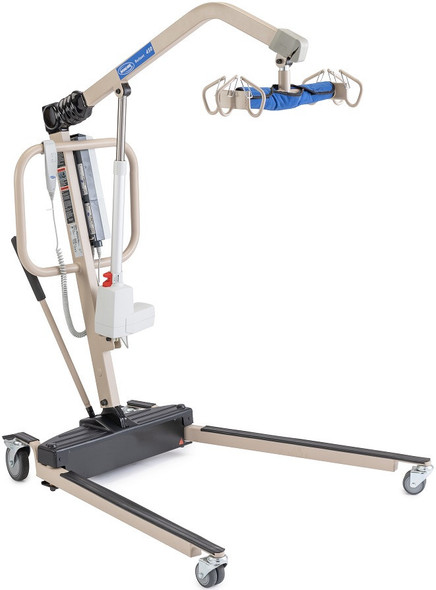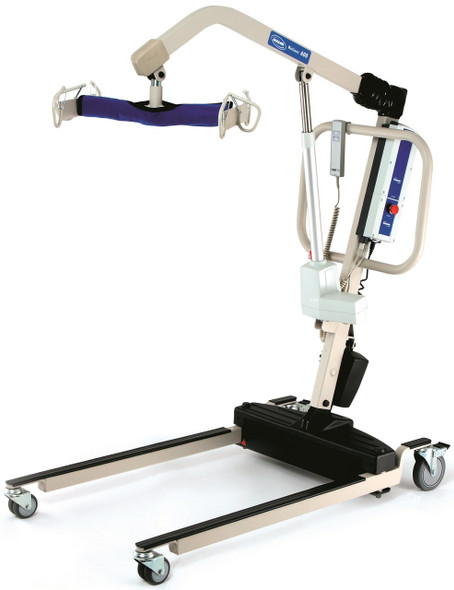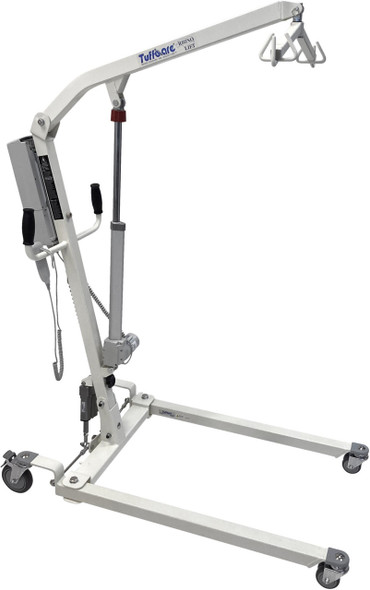Description
The Invacare® Reliant RPL450-2 battery-powered electric hoyer lift was conceived to prevent caregiver back injury and to ensure dignity in patient handling. These high-quality patient lifts for home use are comfortable, reliable and an integral tool for staff and caregivers. The new higher lift range allows easy access to beds, chairs, toilets, floors, and tubs. The sturdy and practical design of Reliant patient lifts provides the solution you need for success in your quest to provide safe and effective health care.
CLICK HERE FOR OWNER'S MANUAL (opens in new window)
Introduction to Invacare Lifts and Slings
[Picture with text read by a man]
Practice transfers often so that you become proficient at the task before you try to lift a resident.
Practice lifts from bed to wheelchair or chair, from chair to bed, and floor to bed. Read and understand the owner-operator's manual.
Safety is most important when performing lifts, and that includes your safety. Always use good body mechanics. Keep your center of gravity low and use your leg muscles. Separate your legs to establish a broad base of support. Keep your spine in natural alignment and never twist while lifting.
Always inspect the resident's sling before using it.
Check for wear, tears, and loose stitching. Bleached, torn, cut, frayed, or broken slings are unsafe and should not be used.
[Music and picture with title Powered Full Body Lifts]
[An old woman is lifted with the help of a sling and two caregivers are assisting.]
[An obese woman is lifted by a sling and again two different caregivers are assisting.]
Invacare's Jasmine and Reliance series full-body lifts are valuable tools for lifting and transferring non-ambulatory, bedridden, or obese patients. These battery-powered designs make it easier to assist any patient within the weight capacity of the equipment.
They can lift a person from a bed, a stretcher, a wheelchair, a commode, even the floor. Depending on the model, the lifts can handle patients that weigh up to 600 pounds.
[A man dressed in blue shirt explaining lifts and slings]
To get a better understanding of a Reliant or Jasmine lift, it's good to know the parts.
[The man tells about the parts of the lift by touching the different parts of the lift with his hand]
Basically, the lift is made of three assemblies: the base, the mast, and the boom. Let's start at the bottom and work our way up, beginning with the base.
[The man shows the base of the lift.]
The base rides over the floor on these four low friction casters. The rear ones are lockable; this is a feature that comes in handy when you're adjusting the sling for initial setup on the patient, as you'll see later.
Next are the legs. There are two of them, and they're adjustable. With the legs closed, the lift can be maneuvered more easily through doors, around furniture, and in tight hallways.
[The man shows how the legs of the lift are opened with the help of a control.]
Jasmine lifts and some Reliant lifts have motorized legs that open and close with the touch of a button. Other Reliant lifts have manually operated legs.
To make adjustments on these, you have to use the padded shift handle.
[Man shows how to use the padded shift handle.]
It's pretty simple to open the legs: grab the shifter handle with one hand and the steering handle with the other hand, pull back on the shifter handle, and move the handle to the right. The legs will open.
Make sure that the handle drops into this slot to lock the legs into place. To close the legs, just reverse the process. Grab the shifter handle with one hand and the steering handle with the other, pull back, and move the shifter handle to the left, and the legs will close again. Make sure that the handle drops into this slot to lock the legs into place.
We can't emphasize enough the importance of making sure the legs are locked in the open position when lifting a patient. The lift is most stable when the legs are fully opened and locked; they must be fully open to ensure proper weight distribution and balance.
[Man shows different parts of the mast.]
The next assembly is the mast. Here you'll find these ergonomically designed push handles, a hand pendant which houses the operator's controls, the battery, a control box, and the actuator which actually lifts the patient.
Attached to the mast is the boom. The boom is the lifting arm, and at the end of it is the swivel bar. The sling attaches to the swivel bar, and it's padded for safety. The boom is operated by using the controls on the hand pendant. With the push of a button, you can gently raise or lower the boom. It's very smooth and quiet.
Power for these lifts comes from a 24-volt battery. Each unit comes with two and a wall-mountable battery charger, so you can have one battery powering the lift while the other battery is on the charger. It takes about four hours to fully charge a battery. You can make about 200 lifts before a battery needs charging, and you'll know when it needs to be recharged because this alarm will go off when the battery is low.
[Man shows the charger and the control box.]
With Jasmine lifts, the charger is designed so that you can mount it on the wall or on the lift itself. The Jasmine control box has a visual battery indicator that's like a fuel gauge, so you can know at a glance how much power is left.
On both units, replacing the battery is easy. First, squeeze the handle here on top; this will unlock the battery from the mount. Pull the battery towards you to clear the bracket, then lift the battery up and towards you. You might find it easier if you use two hands for this part.
[Man shows how to mount the battery.]
Mount a fresh battery by sliding it along the bracket until it rests in the cradle, then push it away from you until you hear it click into place. Place the drained battery on the battery charger the same way: slide it down and push it away until you hear it click.
[Man shows the on and charge lights.]
If the charger is plugged in, this green light will be on, and if you have properly installed the battery, this LED will light up to let you know that the battery is being charged. When the battery is fully charged, the LED will go out. It's recommended that you leave the battery on the charger until you need to use it. The charger will trickle charge the battery to make sure that it's always at full capacity, and daily charging will prolong the life of the batteries.
[Man shows the red stop button on the control box.]
If for some reason you need to shut off all power to the lift, you can deactivate it by pushing in the stop button on the control box. To restore the power, rotate the stop button to the right.
It's very unlikely, but if you ever need to lower the lift and the power unit fails, you can safely lower the boom by activating the emergency release. Invacare lifts have two primary emergency release and a secondary emergency release.
To activate the primary release on Reliant models, insert a pen or similar object into this hole on the control box labeled "emergency down." This will cause the actuator to retract and slowly lower the boom. If that doesn't work or if you can't get to it, you can use the secondary mechanical emergency release, which is located here near the base of the actuator. To activate the secondary release, pull up on the emergency tab and push down on the boom at the same time; this will slowly lower the boom. There must be weight on the boom for this mechanical release to function.
[Man shows the emergency up and down arrows on the control box with the help of a pen.]
The primary emergency releases on Jasmine lifts are more sophisticated. They're here on the control box. There's an emergency up and an emergency down release. Like the Reliant release, insert a pen or like object into the appropriate hole, up if you want to raise the lift or down if you want to lower it; this will move the actuator independently of the hand pendant controls. The secondary emergency release on the Jasmine lift is located on the actuator. Pull up on the red emergency sleeve; this will slowly lower the boom. There must be weight on the boom for this mechanical release to function.
Another safety feature built into all our battery-powered lifts is an anti-entrapment capability. An internal sensor will automatically stop the lift if it meets any kind of resistance while it's lowering.
[Man now shows a blue colored sling.]
In the care offers a wide selection of slings to meet most situations. They're constructed of soft, durable mesh or solid fabric with padding for extra comfort.
[An obese woman in blue clothes is demonstrating how the sling is used.]
Although one sling works for multiple residents, it's recommended that each resident be issued their own individual sling to meet their specific size, weight, medical condition, and transfer requirements. Always check with a physician before selecting a sling.
[Picture with three different sling categories is shown.]
Generally, slings fall into one of three categories: full-body, divided leg, or universal toileting slings. The full-body and divided leg slings have built-in headrests for patients with limited stability, and the full-body sling has an optional commode opening. The divided leg and toileting slings fit around a seated person and provide added comfort with padding under the thighs.
Always inspect the sling before use. Check for wear, tears, and loose stitching. Bleached, torn, cut, frayed, or broken slings are unsafe and shouldn't be used.
You can adjust the slings for different body positions by using different combinations of color-coded loops that are sewn into each strap.
[Picture shows reclining position where a man is reclined in a sling.]
If you want to position the resident in a reclining position, attach the sling using the loops at the end of all four straps. If you want to position the resident in the seated position, for the head, use the loops closest to the resident, and for the legs, use the loops farthest away from the resident.
[Man shows the grab straps.]
Most slings have reinforced grab straps sewn into the back to assist you in guiding your resident. Although Invacare lifts and slings have been designed so they can be safely operated by one caregiver, it's recommended that two caregivers perform all resident transfers.
Before you attempt any kind of lift, make sure that you understand the resident's limitations and their ability to assist the transfer.
[An old woman on the bed is assisted by two caregivers.]
It's a good idea to communicate with a resident throughout the process. If you explain each step as you work through it, your resident will learn the routine and become comfortable with it.
Product Features
- Hand pendant operates battery operated boom height and base width
- Height range allows lifting from floor and high surfaces
- Low friction casters significantly improve rollability and contributes to caregiver safety
- Manual lowering for instant response to power loss
- Multi-grip push handle is angled to minimize wrist strain
- Safety-tested with (CE) mark for highest quality standards
- Anti-entrapment if boom meets any resistance while lowering
- Hand pendant controls boom height and base width
- Total pinch-point protection covers all moving parts for added safety
- Padded swivel bar on patient lift with 360 degrees rotation and six-point hookup allows use of an Invacare chain-free patient lift sling as well as an older-style sling with chains or straps
- Attractive neutral patient lift design blends well into any environment
- Covered base provides protection against wear, dirt and moisture
- Manufactured in an ISO9001 facility
Specs
- Power operated patient lift base width adjusts 26.5" - 41" wide
- Hand control operates boom height 24" - 74" at sling attachment from floor
- Hand control cord extends up to 8 feet long
- 3" front casters and 5" locking rear casters
- Base height (under bed clearance) is 4.5" for at home patient lift use
Includes
- Battery charging station
- 2 each, 24-volt batteries: one for patient lift, one for battery-charging station
- Manual emergency lowering device
Warranty
- Invacare limited 3 year warranty on lift
- 1 year warranty on electronics and motors
- 6 months on batteries
Manufacturer Resources
To speak with a customer service representative, call 1-800-956-6616
- Hand pendant operates boom height and base width
- Emergency stop and manual lowering device
- Includes two batteries and charger
- Accommodates 2, 4 or 6 point slings
- Base height 4.5" for under bed clearance
- Lifts up to 450 lbs.
Specifications
| Height at Sling Hook-up: | 24" - 74" |
| Base Height: | 4.5" |
| Base Width: | Open: 41" Closed: 26.5" |
| Base Length: | 48" |
| Casters: | Front: 3" Rear: 5", locking |
| Product Weights: | Base w/ Casters: 55 lbs. Mast w/ Battery: 38 lbs. Boom w/ Hanger: 16 lbs. |
| Total Weight: | 109 lbs. |
| Shipping Weight: | 145 lbs. |
| Batteries (2): | 24V DC |
| Battery Charger: | Input: 100V-240V AC Output: 29.5V DC |
| Charging Time: | Max. 6 hrs. |
| Lifts per Charge*: | 150-300* |
| Weight Capacity: | 450 lbs. |
| Warranty | |
| Lift: | 3 years |
| Pump/Electronics: | 1 year |
| Battery: | 6 months |
| *varies with lift range and load | |
Additional Information
_lowestprice: |
RPL4502 |
Weight Capacity: |
450 lbs. |
Special Features: |
Backup Battery |
Special Features: |
Power Base |































